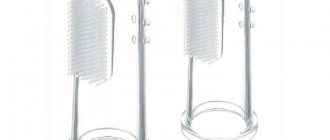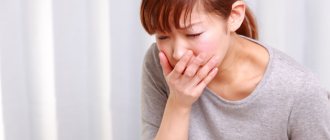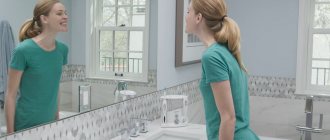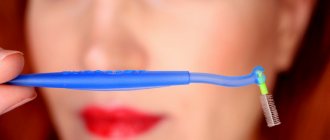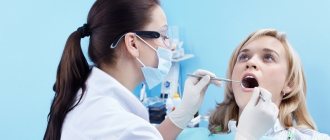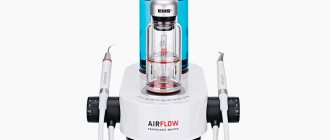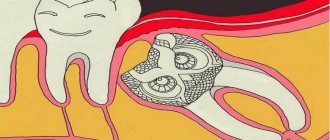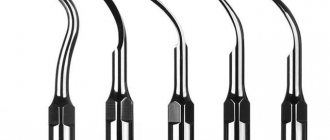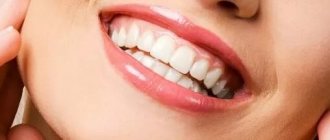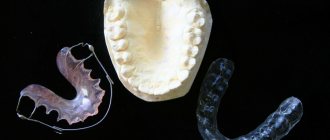Everyone strives to take care of their health and appearance. The condition of your teeth also plays a big role in this matter - many people want to have a snow-white smile, which helps create a good impression when communicating with people. How many times is it necessary to brush your teeth to maintain good oral hygiene, because a correct and comprehensive approach is of great importance in this.
In adults
Brushing your teeth in the morning removes plaque accumulated during the night, gives your teeth a clean look and ensures fresh breath. However, you should not brush your teeth immediately after breakfast, since after eating, the enamel is most sensitive and susceptible to destruction. The duration of brushing your teeth should be 2-3 minutes, on average 1 minute for each jaw. Unfortunately, very often teeth are brushed in a hurry, without devoting the necessary time to oral hygiene. Such care can cause plaque formation and gum inflammation. Bacteria accumulated under plaque destroy tooth enamel and cause inflammation in the oral cavity. Proper hygiene prevents the development of caries and gum disease.
Three common mistakes
These mistakes lead to inflammation of the gums, the development of caries, and wedge-shaped defects.
- Move not from top to bottom, but from right to left horizontally. With this approach, food accumulates in the gaps, which leads to the destruction of the enamel.
- Store the brush in the bathroom without a cap and rinse it rarely. Due to high humidity, bacteria quickly accumulate on the bristles. To avoid this, rinse the brush thoroughly each time after the procedure and store it in a plastic case.
- Use regular thread instead of dental floss. Never do this! A regular thread is not sterile, which means it can lead to infection.
The child has
Brushing your teeth in childhood is an important point, since habits formed in childhood most often contribute to the formation of the right attitude towards hygiene and your health in the future. Caring for children's teeth is slightly different from hygiene for adults. When your child's first baby teeth erupt, you should begin caring for them. To do this, you need to carefully wipe them with special sanitary napkins or gauze soaked in warm boiled water. You can also purchase special silicone brushes and pastes designed for babies that are safe to swallow. You need to start brushing your teeth once a day, gradually accustoming your child to the fact that the procedure is regular. Once your child gets used to it, you can add one more dental hygiene routine to the day. In adulthood, the hygiene process must be under the supervision of an adult in order to explain to the child the correct cleaning technique. It is extremely important that brushing teeth does not cause negativity in the child, for this you should come up with some kind of encouragement or incentive.
When to have a professional cleaning
During professional cleaning, the doctor removes hard tartar and soft plaque from the entire surface of the oral cavity. Next, the enamel is polished with abrasive pastes and a special gel with fluoride is applied.
The doctor performs the procedure in four stages:
- Tartar is removed using ultrasound. The device is called a scaler; its work is to supply a pulsating stream of water. The scaler tips vibrate, creating millions of air bubbles. The bubbles burst and a cavitation effect occurs, which helps remove bacterial deposits from the surface of the teeth.
- Remove pigmented plaque. Which was formed due to drinking coffee, tea, and smoking. A device is used that delivers a stream of water with dental soda and air bubbles. The soda granules have a spherical shape, which allows you to thoroughly polish the enamel in hard-to-reach places, even in the gingival sulcus and between the teeth. Fashion also allows you to whiten the color of the enamel, lightening it by 1-2 tones.
- Re-polish the enamel. For the procedure, special rubber brushes and medicated toothpastes are used.
- A special paste is applied to the enamel surface, which contains high doses of fluoride. This procedure prevents the development of caries and reduces the sensitivity of the enamel.
How often tartar and pigmented plaque on teeth are cleaned depends on the condition of the enamel, as well as a number of other factors. Theoretically, the procedure can be performed once every 6 months. If you are undergoing orthodontic treatment or suffer from periodontal disease, you can come once every 4 months. Consult your dentist about how often you should brush your teeth. The procedure has a number of contraindications; it cannot be performed without a doctor’s prescription.
Remember that the secret to a beautiful smile is taking care of your teeth. Care must be comprehensive and regular. Always take care of your oral health and then no one can resist your smile.
Why is it harmful to brush your teeth frequently?
Some people are convinced that the more often you brush your teeth, the better. Although this opinion is false. You should not clean the tooth surface immediately after eating, as the enamel during this period is weakened and susceptible to destruction. By cleaning, you can damage the surface of the enamel and create microcracks, into which bacteria can later enter, the proliferation of which can provoke various dental diseases. Also, if you brush your teeth frequently, you can damage your gums, which can trigger the development of inflammation in the periodontal tissues.
Possible contraindications
Despite the safety of hygienic cleaning, this procedure is contraindicated for some patients. It is not recommended if you have:
- arrhythmias;
- increased sensitivity or erosion of enamel;
- gingivitis;
- acute respiratory diseases.
Dental hygienic treatment is prohibited for pregnant women and adolescents who have not changed their primary dentition to a permanent one. If there are contraindications, the doctor can carry out the procedure manually or using special pastes and attachments for a drill. This will allow you to simultaneously remove deposits and polish the enamel.
How to clean correctly
Brushing your teeth should take at least two minutes. At first, you can use a stopwatch to develop a habit. You need to brush your teeth with light, sweeping movements, paying special attention to hard-to-reach areas. Every area of the mouth should be thoroughly cleaned. The process of hygienic oral care can be divided into several stages of cleansing:
- The outer surface of the teeth first in the upper jaw and then in the lower jaw.
- The inner side of the teeth of the upper and lower jaws.
- Chewing surfaces of teeth.
- Surface of the tongue.
Some toothbrushes have a special surface on the back for cleaning the tongue.
Proper Teeth Brushing Technique
The dentition contains many so-called hard-to-reach areas in which food debris collects and plaque accumulates. To remove it as well as possible, you need to brush your teeth properly. The following rules can help with this:
- Toothpaste must be applied in sufficient quantities, but without fanaticism - the length of the strip should be approximately one centimeter.
- Using swiping movements from the gums, we clean the chewing teeth from the cheek side.
- We brush the front teeth in a circular motion and from side to side.
- We perform 20 movements on each section and then move on to the next one.
Using a toothbrush, you should thoroughly clean your teeth on all sides, not forgetting your tongue, because bacterial plaque accumulates on it too. Finally, rinse your mouth with clean water.
The nuances of choosing a toothbrush and toothpaste
Today there is a wide range of different models of toothbrushes. When choosing, you need to consider three main parameters:
- Rigidity.
- Form.
- Size.
For sensitive teeth, the best option would be a brush with soft bristles that do not harm the enamel and gums. For less sensitive enamel, you can use a brush with medium-hard bristles. Such brushes provide maximum cleaning of teeth from plaque, but at the same time, they injure the enamel the most.
The shape of the toothbrush should be selected based on personal preference. It is best to purchase a brush yourself, following the recommendations of your treating specialist. When choosing a size, it is better to assume that the head is small. Such a toothbrush will allow you to reach all, even the most inaccessible places in the oral cavity, which will help ensure the most thorough dental hygiene. It is recommended to replace the brush with a new one once every 3 months or even more often, depending on wear. You should also replace the brush after getting rid of dental diseases, since pathogenic microflora may remain on the bristles. It is also important to approach the choice of pasta individually. Currently, there are a huge number of all kinds of pastes that solve various problems - the prevention of dental diseases, for example, caries or tartar, increased sensitivity of teeth or bleeding gums. To select the necessary paste, as well as brushes, it is better to contact a specialist. He will help you choose hygiene products individually for each oral cavity.
How often should you change your brush?
The oral cavity is one of the most microorganism-populated places in the human body, and no matter how thoroughly you clean your toothbrush after each use, it is impossible to completely clean it, so gradually the microbial contamination of the brush grows, at the same time the bristles wear out and become deformed, and its cleaning properties deteriorate. Therefore, the toothbrush must be replaced regularly.
Dentists recommend changing your toothbrush at least once every three months. In the presence of periodontal disease, the brush is changed more often. Some brushes have colored bristle indicators, which make it easier to control the timely replacement of the brush. It is also recommended to change your toothbrush after suffering from viral, infectious and so-called colds. The brushes that you take with you on the road should also be thrown away upon arrival. You need to store the brush with the bristles up, in an open place, and first rinse and clean it thoroughly.
Therapeutic and prophylactic pastes
These pastes contain substances that have an antibacterial effect. Their effect is to reduce inflammation and prevent the development of caries. Such pastes should be purchased on the recommendation of a specialist in pharmacies.
Such pastes are divided into:
- Contains extracts of medicinal herbs and essential oils that help relieve inflammation and accelerate tissue regeneration processes. The essential oils in the composition help eliminate bad breath.
- Containing minerals and salts, which helps strengthen tooth enamel, accelerate tissue healing and reduce plaque formation.
Additional oral care products
Such hygiene products enhance the effect of brushing your teeth and help maintain oral hygiene in between brushings. 1. Dental floss or floss. Using dental floss helps remove food debris from between the teeth, which is not always possible even with a toothbrush. There is a wide range of flosses on sale. Their use does not take much time. 2. Mouth rinses. Such liquids are convenient to use to freshen breath, although they also have other purposes. Mouthwashes contain bactericidal substances that fight bacteria that cause various diseases in the oral cavity. You should pay special attention when choosing a mouthwash for your child, since most of them contain alcohol. Alcohol-containing mouthwashes should not be used in children. It is necessary to use mouthwash after brushing your teeth or eating food. The rinse duration should be approximately 30 seconds.
There are a large number of hygiene products that help you perform the necessary oral care. They should be used correctly to reduce the number of trips to the dental office.
Why do you need teeth cleaning at the dentist?
Let's consider what professional oral hygiene is and how often should you brush your teeth at the dentist?
Professional cleaning at the dentist implies the most complete and high-quality removal of hard and soft dental plaque. At home, it is impossible to remove all plaque with a regular toothbrush. If you use additional products, the cleaning of the oral cavity will be better, but still not sufficient. In order to treat hidden and hard-to-reach areas, you need special equipment, which is only available in dental offices. Professional cleaning is also necessary before the teeth whitening procedure.
Professional cleaning of the oral cavity can be carried out in various ways, which can be divided into hardware and manual. The first group includes:
- Ultrasonic cleaning. The effect of ultrasound on the tooth surface creates vibration, which repels plaque and tartar. The frequency of exposure can be adjusted to achieve maximum effectiveness and maintain safety.
- Air flow cleaning. Unlike the previous method, teeth are cleaned under the influence of a stream of air, which is supplied under pressure. To make the procedure more effective, a special cleaning mixture is supplied to the air flow.
- Laser cleaning. It is used to remove all types of dental plaque, but at the same time it is more gentle than ultrasonic cleaning. The device is configured in such a way as to evaporate water from plaque and destroy it without affecting healthy tissue.
Manual cleaning involves the use of various tools with which the doctor can remove plaque and tartar from the most difficult to reach places, such as wisdom teeth. Unlike manual home brushing of teeth, in this case the cleaning of the oral cavity is performed more efficiently. In addition, manual cleaning can be combined with hardware methods. In such cases, it is performed at the final stage.
Each of these methods has its own characteristics, so they are selected purely individually. To ensure the health of teeth, and the entire oral cavity, everyone needs to carefully engage in the prevention of dangerous diseases. To do this, you do not need to frequently brush your teeth at the dentist. As the experts themselves advise, it is enough to perform this procedure once every six months. For convenience, it can be combined with a preventive (twice a year) visit to the dentist.
However, many people are interested in: is it possible to brush your teeth if you have stomatitis? how to brush your teeth with periodontal disease; Does it hurt to clean stones on your teeth? how to brush your teeth after dental implantation; how to clean cermet teeth?
To find out whether your oral cavity requires professional care or whether you can handle it on your own, how often to brush your teeth at the dentist, you need to make an appointment at our clinic for a free appointment with a specialist. The doctor will conduct an examination and help you choose a specific cleaning method, if indicated. If teeth need urgent hygienic treatment, the procedure can be performed immediately.
If you have the symptoms described in this article, be sure to make an appointment at our clinic.
Don't self-medicate! Even the smallest problem, if not treated correctly, can significantly complicate your life.
By contacting us, you can be sure that:
- Get high-quality and free consultation .
- You will receive the best prices for treatment and the opportunity to receive a special promotional price.
- Only modern equipment and materials will be used.
- You will be treated by professional doctors with many years of experience.
- We offer treatment on credit or in installments. There is also the possibility of obtaining a tax deduction.
- We work seven days a week and without a lunch break, from 9 a.m. to 10 p.m.
+7 (495) 132-02-96
Make an appointment
